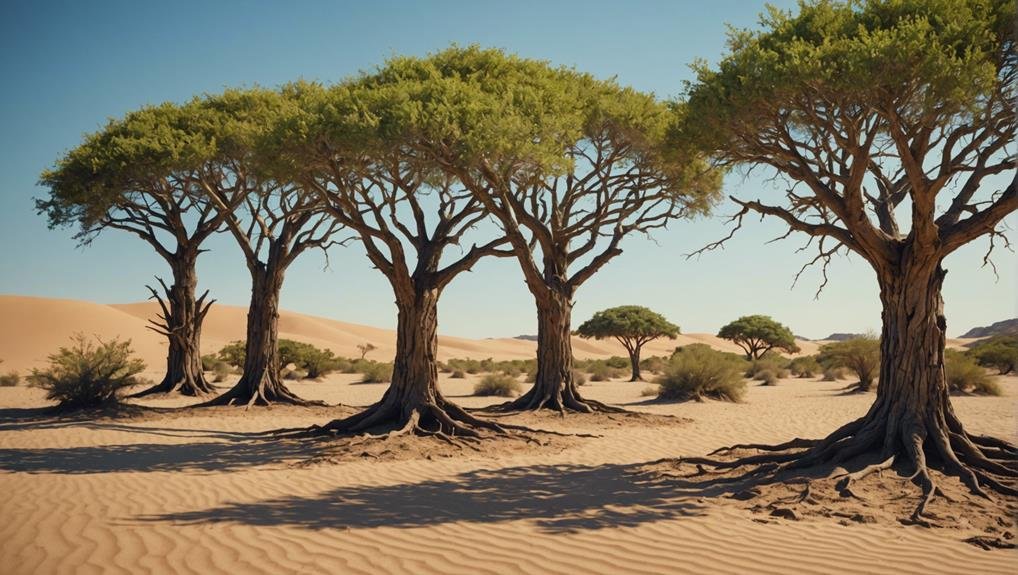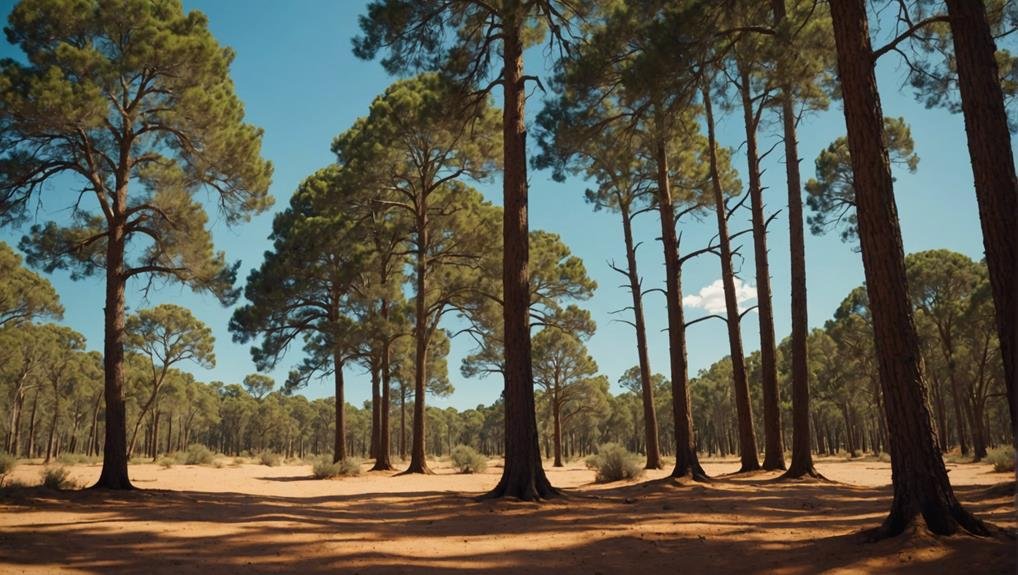When dealing with sandy soils, certain trees stand out for their ability to thrive in such conditions. White pine (Pinus strobus) and red cedar (Juniperus virginiana) are excellent choices. White pine prefers slightly acidic soils and plenty of sunlight, while red cedar is known for its adaptability to various soil types, including sandy ones. Ginkgo biloba is another great option due to its drought tolerance and long lifespan. The silk tree (Albizia julibrissin) grows quickly and has a unique appearance, but it requires monitoring to prevent invasiveness. Additionally, trees like Hackberry, Black locust, and Northern red oak contribute to the ecological value of sandy soil environments. For more detailed information, further exploration is recommended.
Some of the links in this article may be affiliate links. If you make a purchase through these links, we may earn a small commission at no extra cost to you. Thank you.
Pine Trees Group
Within the Pine Trees Group, the White pine (Pinus strobus) stands out for its remarkable growth rate and historical significance. This species is known for its rapid growth, reaching up to 3 feet per year, making it a valuable choice in pine tree cultivation. White pines thrive in slightly acidic soils with full sun exposure, particularly suited for sandy soil conditions. Historically, White pines have played a crucial role in colonial home and shipbuilding industries. Their fast growth and adaptability to different soil types make them ideal for reforestation and landscaping projects. The White pine offers substantial ecological and economic benefits, making it a key player in forestry practices.
Cedar Trees Group
Red cedar, scientifically known as Juniperus virginiana, stands out for its adaptability and resilience, particularly in sandy soils. This tree, native to eastern North America, plays a crucial role as a pioneer species in restoring damaged ecosystems, showcasing exceptional toughness. With a lifespan spanning hundreds of years, red cedar is a sustainable option for reforestation and erosion control initiatives. Thriving in various soil types, including dry, sandy, and loamy conditions, this tree requires minimal upkeep once it takes root. Its dense foliage not only creates effective windbreaks but also provides essential habitat for wildlife, contributing significantly to ecosystem stability.
Unique Trees Group

The Ginkgo biloba, known for its unique fan-shaped leaves and strong resilience, is a standout choice for sandy soils due to its exceptional ability to withstand drought conditions and its impressive longevity. These trees are dioecious, meaning they have separate male and female specimens, which can be advantageous for managing fruit production. Thriving in full sun, Ginkgo biloba may have a slow growth rate but can live for centuries, making it a remarkable addition to landscapes with poor soil quality.
Its drought resistance makes it perfect for areas with limited water, while the separate male and female trees contribute to their longevity. The slow growth rate not only adds to their lifespan but also requires minimal maintenance. With a preference for full sun exposure, Ginkgo biloba is an excellent choice for diverse landscaping needs.
Exotic Trees Group
Shifting our focus from the resilient Ginkgo biloba, let's explore the Silk tree (Albizia julibrissin), which brings an exotic touch to sandy soils with its rapid growth and stunning summer blossoms. Originating from Asia, this tree thrives in dry and semi-arid conditions, making it well-suited for sandy terrain. Its exotic flowers in the summer attract a variety of pollinators, enriching the local ecosystem. However, due to its fast growth and potential invasiveness, it requires careful management to prevent it from outcompeting native plants. Despite these challenges, the Silk tree's adaptability and beauty make it a popular choice for landscaping. While it adds a touch of the exotic to gardens, it's essential to monitor it regularly to maintain a balance with the environment and promote sustainability.
Diverse Tree Species Group

The Diverse Tree Species Group features a selection of resilient trees that thrive in sandy soils, benefitting both the environment and visual appeal of landscapes. These trees play a crucial role in creating robust habitats for wildlife and supporting conservation initiatives. They help enrich the soil and enhance water retention, which are essential for maintaining healthy ecosystems. Key species within this group include the hardy Hackberry, known for providing habitats for birds, the nitrogen-fixing Black locust that improves soil fertility, the aesthetically pleasing Flowering crabapple trees that serve as vital food sources for wildlife, and the Northern red oak, which offers durable wood and supports diverse wildlife habitats.
Conclusion
Choosing the right trees for sandy soils involves considering adaptability, growth patterns, and ecological benefits. Native species like white pine and red cedar demonstrate resilience in such conditions, while exotic trees such as eucalyptus and silk tree also thrive. Olive trees, known for their drought resistance, and acacias, which fix nitrogen in the soil, offer significant ecological advantages. Additionally, black locust trees can grow up to 24 inches per year in optimal sandy soil conditions, showcasing their rapid growth potential.

